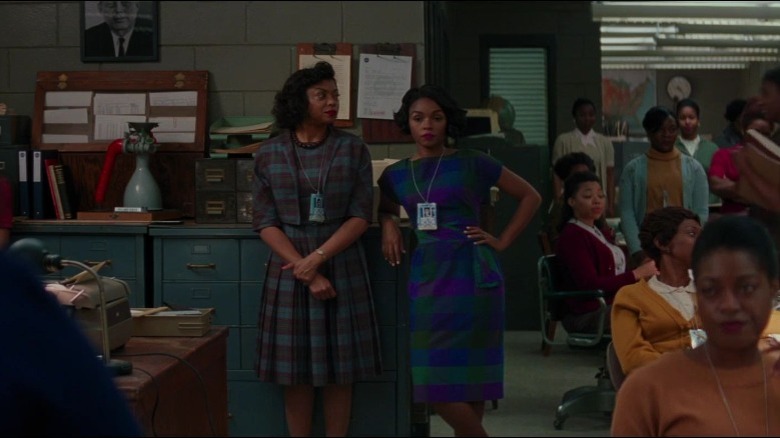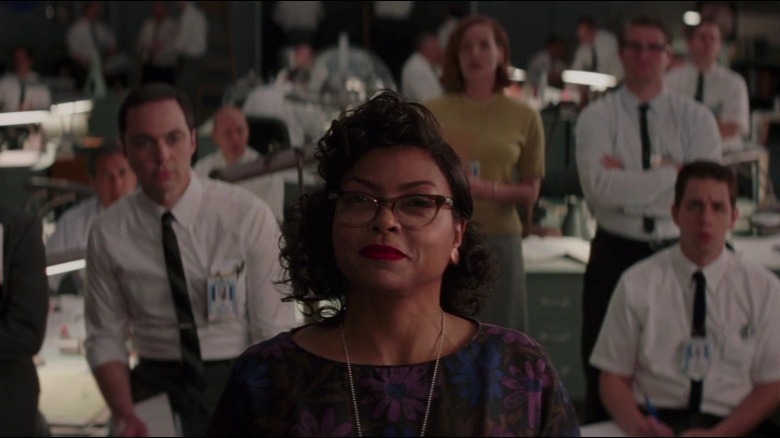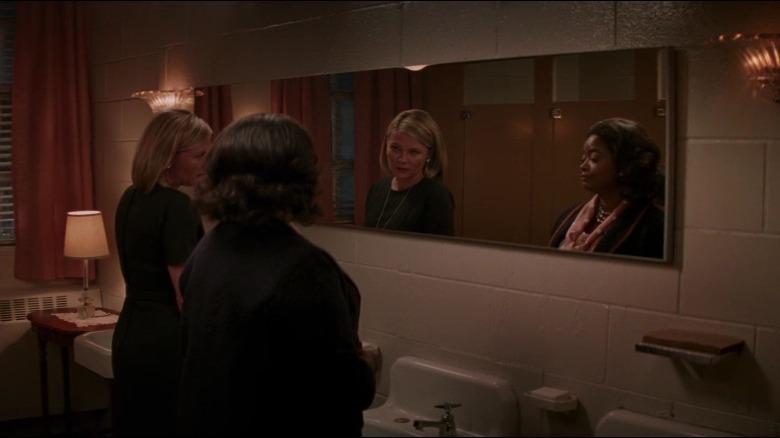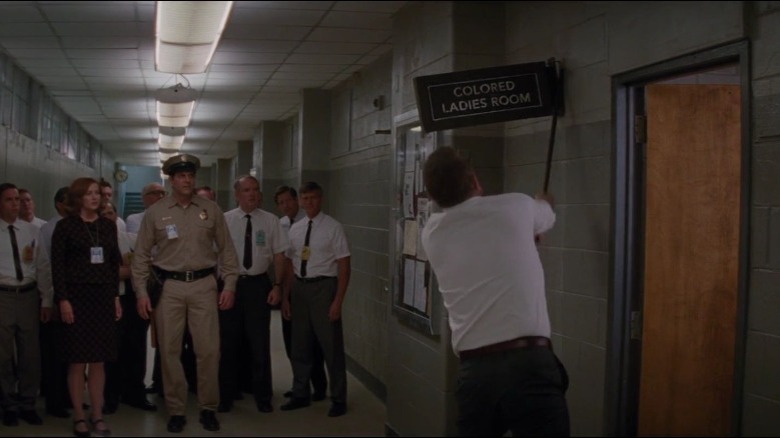How Accurate Is Hidden Figures?
"Hidden Figures" is one of the most successful studio dramas of the past decade. The story of African American NASA mathematicians Katherine Johnson, Dorothy Vaughan, and Mary Jackson and their contributions to the U.S. space program swept through America like a storm, grossing over $169 million domestically (via Box Office Mojo), nabbing a rare A+ Cinemascore and riding a wave of pop culture enthusiasm all the way to three Academy Award nominations, including one for Best Picture.
One of the major factors in the movie's enormous success was the fact that it introduced the public to an unsung part of 20th-century history. Millions of Americans were unaware that three Black women had not only carved out a space for themselves at NASA at the height of racial segregation in the U.S. but were actually key players in the arduous struggle to get man to space. The flair and reverence with which "Hidden Figures" presents the achievements of Johnson, Vaughan, and Jackson helped make the movie an irresistible crowd-pleaser.
But how much of the history depicted in it is actually true to life? Inevitably, there was some embellishment in the process of adapting the source material, the eponymous non-fiction book by Margot Lee Shetterly. But even so, the protagonists of "Hidden Figures" were really that extraordinary in real life.
The reality of the space program was a lot more collective-based
Katherine Johnson, Dorothy Vaughan, and Mary Jackson were, indeed, brilliant mathematicians who made invaluable contributions to the U.S. space program. Via NASA, Vaughan was the first Black supervisor at the advisory committee that would later become NASA and a crucial advocate for the rights of the program's women "computors"; Jackson became the agency's first Black female engineer; and Johnson's incredible calculation skills played a key part in the planning of Project Mercury and Apollo 11, among other missions. They all belong to the long, storied tradition of female scientists who do not get nearly enough credit for their historical importance.
But, while the women were indeed trailblazers for the crucial contributions they put in at a time of racial and sexual discrimination, the reality of the space program, as described in Shetterly's book, was a lot more collective than the film's bent towards the characters' individual heroics might suggest. Vaughan mastered the IBM 7090 computer as part of a large team as opposed to figuring it all out on her own, and there's no record in the book of Johnson being singled out for any "testing" of her math skills by Pentagon officers. All records indicate that she was simply treated as a peer by her colleagues, no more or less important than any other scientist on hand.
The screenplay takes some artistic liberties
Although the overall arc of the space-race plot of "Hidden Figures" is pretty accurate, several liberties were taken. For one thing, as depicted in Shetterly's book, Johnson (Taraji P. Henson), Vaughan (Octavia Spencer), and Jackson (Janelle Monáe), although friendly, were not quite BFFs as they are in the film, and did not commute together; in fact, Johnson carpooled with Eunice Smith, another Black mathematician who worked at NASA at the time, according to That Was Not in the Book.
Per the NASA website, the characters of Al Harrison (Kevin Costner), Vivian Mitchell (Kirsten Dunst), and Paul Stafford (Jim Parsons) are all composites, meant to represent attitudes of the time — and, in Harrison's case, the NASA hierarchy at large — rather than any specific historical figures.
The timeline is also a little off; by 1961, the year the film is set, Johnson had already transferred to the Space Task Group along with the rest of the Flight Research Division, Vaughan was already a supervisor, and Jackson was, by that time, an engineer. Johnson's marriage to Jim Johnson (Mahershala Ali) also occurred much earlier.
Finally, the film's climax is significantly exaggerated for impact: John Glenn did request that Johnson manually calculate his orbital trajectory to make sure it was correct, but she did it over several days, not in a few seconds right before the launch; that would have been humanly impossible (via collectSPACE). And she did not watch the launch from the control room, but from her office, on television.
Racial segregation at NASA looked a bit different
Racial segregation was still very much a major problem in the U.S. in 1961, but the specifics in "Hidden Figures" are a bit off. Although the West Area Computing unit of Langley did exist, it was abolished along with all other segregated facilities when the National Advisory Committee for Aeronautics (NACA) became NASA in 1958. At the time the movie is set, NASA and all of its divisions were already integrated.
That didn't mean discrimination no longer existed, of course — especially considering segregation laws were still in place in Virginia at the time. Shetterly's book does mention Mary Jackson's frustration at having to look for a colored bathroom during her time at Langley, and it is true that, up until 1958, the Langley Research Center was heavily segregated despite the significant presence of Black staff. But Katherine Johnson herself never bothered to look for a colored bathroom and just used whichever one was closest. In fact, she has gone on record saying she did not personally feel discriminated against at NASA (via History vs Hollywood).
Still, Mary Jackson did have to file a petition with the City of Hampton to be able to attend classes at the whites-only Hampton High School, and, even though the process was not as taxing as in the movie — she was granted special permission and did not have to go to court — Jackson often vented about her distress at the absurdity of segregation to her mentor Kazimierz Czarnecki, upon whom the character of Karl Zielinski is based.
The movie has been accused of fabricating white savior moments
For the most part, the historical liberties in "Hidden Figures" are justified by the movie's mission to serve as an entertaining, family-friendly primer on these women and their importance. Even if NASA was officially integrated by 1961, for instance, segregation still informed the conditions of Johnson, Vaughan, and Jackson's lives and the challenges they had to face in their careers. But one fabricated element of "Hidden Figures" did draw heavy criticism: its recourse to the "white savior" trope.
Specifically, a climactic scene — in which fictional Space Task Group head Al Harrison, horrified upon learning the extent of the discrimination faced by Johnson, destroys the "Colored ladies' room" sign with a crowbar and proclaims the end of segregation at NASA — was lambasted by publications such as Vice, which took it to task for "portraying Johnson as being saved by a benevolent white character." After all, Johnson took care of the "bathroom problem" herself, by outright refusing to set foot in the colored restroom; she most certainly didn't wait around until a white superior ended segregation with his own hands.
The scene in which Harrison kindly invites Johnson into the control room during the launch was similarly controversial, not just because that didn't happen, but because, per Vice, it was another example of an "alteration [that] only serves to soothe the conscience of white people." Director and co-writer Theodore Melfi, who is white, defended those scenes, stating "There needs to be white people who do the right thing." Which indeed there were, at NASA and elsewhere — just not exactly those "right things."




